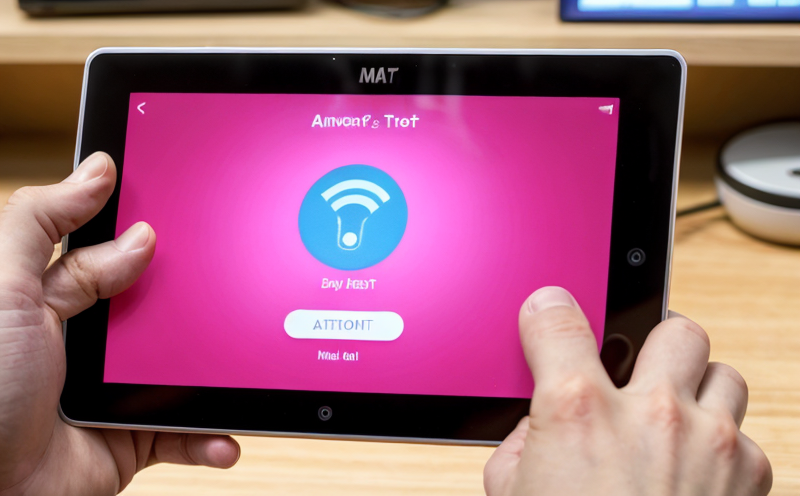Firmware Security Testing in IoT Products
As the Internet of Things (IoT) becomes an integral part of modern consumer products, ensuring firmware security is paramount. Firmware serves as the backbone of IoT devices, managing their hardware and software interactions. Any vulnerabilities within the firmware can lead to significant security breaches, compromising personal data and device integrity. This section delves into the intricacies of firmware security testing in IoT products, emphasizing the importance of this service for quality managers, compliance officers, R&D engineers, and procurement teams.
Firmware security testing is not merely about identifying bugs; it involves a comprehensive evaluation to ensure that the device behaves as expected under various conditions. This includes assessing the firmware's resistance against unauthorized access, ensuring proper encryption of data, and verifying the integrity checks implemented within the system. The process also involves simulating attacks such as buffer overflows, SQL injection, and other common exploits used by malicious actors.
Testing firmware security in IoT devices often requires a multidisciplinary approach, leveraging both hardware and software expertise. This service ensures that all aspects of the firmware are scrutinized for potential weaknesses. The testing process typically involves several stages:
- Initial Assessment: Understanding the device's architecture, identifying critical components, and determining the scope of the test.
- Static Analysis: Analyzing the firmware code without executing it to detect potential vulnerabilities such as uninitialized variables or buffer overflows.
- Dynamic Analysis: Running the device in a controlled environment to observe its behavior and identify any discrepancies from expected performance.
- Penetration Testing: Simulating real-world attacks on the firmware to evaluate its resilience against unauthorized access.
The quality of firmware security testing depends heavily on the expertise of the team performing it. At our laboratory, we employ a team of certified professionals who are up-to-date with the latest trends and threats in IoT security. Our state-of-the-art facilities support rigorous testing protocols that adhere to international standards such as ISO/IEC 27034-1:2015 for Information Security Management Systems related to IT systems.
Our commitment to excellence is reflected not only in our methodologies but also in the equipment we use. We leverage advanced tools like dynamic application security testing (DAST) and static application security testing (SAST) to ensure thorough coverage of potential vulnerabilities. These tools help us identify issues that might be overlooked during manual inspections, providing a more robust defense against cyber threats.
Understanding the implications of firmware security breaches is crucial for any organization involved in manufacturing or distributing IoT products. The consequences can range from financial losses due to data theft to reputational damage and legal penalties. By proactively addressing these risks through comprehensive testing, organizations can mitigate these potential downsides significantly. Our service not only helps in preventing such incidents but also ensures compliance with regulatory requirements.
Moreover, firmware security testing plays a vital role in enhancing user trust and satisfaction. Consumers are increasingly concerned about the safety and reliability of IoT products they use daily. By implementing robust security measures during the development phase, manufacturers can build a strong brand reputation while fostering customer loyalty. This aligns with broader market trends towards sustainability and responsible innovation.
At our laboratory, we pride ourselves on providing not just a service but also valuable insights into how best to approach firmware security testing in IoT products. We offer tailored recommendations based on the unique characteristics of each device being tested, ensuring that every aspect is covered comprehensively yet efficiently.
Applied Standards
Firmware security testing aligns closely with several international standards aimed at enhancing information security and protecting against cyber threats. Key among these are:
- ISO/IEC 27034-1: This standard provides guidelines for IT systems that support Information Security Management Systems (ISMS) within the context of IoT devices.
- ISO/IEC 29147: Focuses on software security testing, providing a framework for assessing the security characteristics of software products including firmware.
- ASTM E3056-18: Offers specific requirements and practices for the security assessment and testing of connected devices.
These standards serve as benchmarks against which our tests are conducted, ensuring that they meet global expectations regarding cybersecurity measures. Compliance with these standards also helps organizations navigate regulatory landscapes more effectively.
Quality and Reliability Assurance
Ensuring the quality and reliability of firmware security testing is critical for maintaining trust in IoT products. Our approach combines rigorous adherence to established protocols with continuous innovation to stay ahead of emerging threats.
We employ a structured methodology that includes:
- Pre-Test Consultation: Engaging early in the process allows us to align our tests closely with your specific needs and objectives.
- Data Collection & Analysis: Utilizing sophisticated tools and techniques, we gather comprehensive data that helps identify areas requiring improvement.
- Reporting & Recommendations: Providing detailed reports along with actionable recommendations ensures you have clear guidance on next steps.
In addition to these structured elements, our team maintains a strong commitment to continuous learning and improvement. Staying abreast of the latest developments in firmware security allows us to refine our methods continuously, ensuring they remain effective even as threats evolve.
Use Cases and Application Examples
Firmware security testing finds application across various sectors where IoT devices play a crucial role. Here are some illustrative use cases:
- Smart Home Devices: Ensuring that smart thermostats, lights, and other home automation systems remain secure against unauthorized access.
- Medical Devices: Protecting patient data in wearable health monitors and diagnostic tools from potential breaches.
- Automotive Electronics: Safeguarding connected cars' onboard systems to prevent hacking attempts that could endanger drivers.
- Industrial IoT: Providing security for manufacturing plants using smart sensors and actuators to maintain operational efficiency while ensuring data integrity.
In each of these scenarios, firmware security testing plays a pivotal role in safeguarding sensitive information and preventing unauthorized access. By implementing robust security measures early in the product lifecycle, organizations can enhance their competitive advantage by delivering secure, reliable products that meet regulatory requirements and customer expectations.





